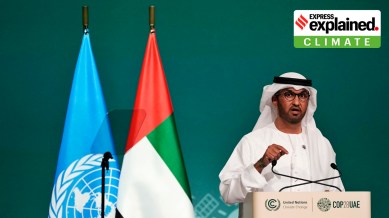Express at COP28: World leaders set to meet in Dubai to bring climate on track, but what are the challenges?
The presence of so many world leaders usually is an attempt to convey the message that climate change is their priority. But more than any earlier climate conference, the Dubai meeting has to produce more than just intention.

All indications are that time may have already run out on efforts to keep the global rise in temperatures within 1.5 degree Celsius from pre-industrial times. And yet, world leaders, business corporations, climate negotiators and activists are congregating in Dubai for the next two weeks to make one more attempt towards that goal, keeping a glimmer of hope by committing to some enhanced and effective climate action in the short term.
Prime Minister Narendra Modi is among those travelling to Dubai for COP28, the climate conference which begins tomorrow and which, like every year, will see a range of global leaders, heads of states and governments.
Modi, who will make an appearance at the climate conference for the third time, after his visits to Paris in 2015 and Glasgow in 2021, would be in Dubai on the first two days of the conference, utilising this opportunity to also hold bilateral meetings with other leaders. This is important in the context of the ongoing Israel-Gaza war almost next door that has altered regional geopolitics and significant implications for India. Israeli President Issac Herzog and Palestinian President Mahmoud Abbas are also among those scheduled to attend.
US President Joe Biden, who came for the last two conferences, is not expected to travel to Dubai this year, neither is Chinese President Xi Jinping slated to attend. But more than 130 other heads of states or governments, including UK Prime Minister Rishi Sunak, French President Emmanuel Macron and German Chancellor Olaf Scholz, are coming.
The presence of so many world leaders usually is an attempt to convey the message that climate change is their priority. But more than any earlier climate conference, the Dubai meeting has to produce more than just intention.
The most important, and keenly awaited, outcome from the perspective of 1.5 degree Celsius target is an agreement on tripling of global renewable energy installed capacity by 2030.
The present installed capacity of renewable energy is a little less than 3,400 GW and the idea is to expand it to over 11,000 GW by 2030. More than 60 countries, including the G20 group, have already endorsed this, a task considered eminently doable.
In itself, this would still not be adequate to hold the temperature rise within 1.5 degree Celsius but it’s absolutely crucial, nonetheless, in reducing significant amounts of emissions in the short term.
The International Energy Agency has estimated that tripling of renewable capacity has the potential to avoid about 7 billion tonnes of carbon dioxide equivalent emissions till 2030. That is about 1 billion tonnes every year on an average. Just as a comparison, all the other current climate actions are expected to result in a net reduction of just 1 billion tonnes of emissions in 2030 from the 2019 levels. COP28 has to deliver much more than just tripling of renewables.
One key agenda is to carry out a global stocktake (GST) of the climate crisis. It is a mandate from the Paris Agreement. Countries have to take stock of the situation every five years, beginning this year, to assess progress being made and decide on what more needs to be done.
The task is cut out. The world is not on track to meet any of the targets that science considers necessary to keep global warming within 1.5 degree Celsius.
In fact, the 1.5-degree threshold is already being breached repeatedly. As the latest Emissions Gap Report, an annual publication of the UN Environment Programme, pointed out, there were 86 days this year until October 15 when the daily average temperature was 1.5 degree Celsius higher than the respective pre-industrial averages.
Almost every month, this year has broken one or the other monthly warming record. It is almost certain that this year will emerge as the warmest ever and it would be no surprise if the annual average breaches the 1.5 degree threshold too. It is not expected to be too long before such a breach becomes the norm.
And yet, climate plans are as inadequate as ever. The annual global emissions are still rising when they need to be at least 43 per cent down from 2019 levels by 2030. US, which accounts for the maximum historical emissions and is still the second biggest emitter after China, plans to reduce its emissions by 50-52 per cent on 2005 levels by 2030.
That translates to just about 45 per cent cut on 2019 levels, which is the bare minimum that the world needs and not the example that developed countries are expected to set in reducing emissions.
But the biggest barrier holding up enhanced climate action has been money. Little money has been directed towards climate action. The required amount, a few trillions of dollars every year, is now two to three orders of magnitude higher than what is available, and is rising rapidly as the cost of inaction escalates.
Developed countries, who have the primary responsibility to make the money available, are likely to claim in Dubai that they have finally met the annual target of mobilising $100 billion, a promise made way back in 2009. But this figure is contested, and even if it was correct, it forms only a small proportion of the requirement.
At last year’s climate change conference in Sharm el-Shaikh in Egypt, countries had agreed to set up a loss and damage fund, which developing countries, hit by climate disasters, can access to rebuild themselves.